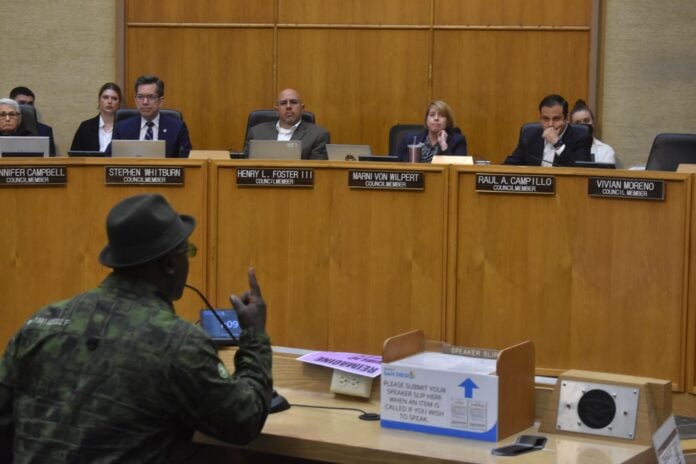
By Macy Meinhardt, V&V Staff Writer, CA Local News Fellow
Facing a staggering $258 million budget shortfall, San Diego officials are rolling out cost-cutting and consolidation measures that will mean higher costs for residents and potential program cuts.
“San Diegans should know that your city government is making tough calls now, so we can avoid even harder decisions down the road,” said Mayor Todd Gloria in a Feb. 18 press conference.
The mayor has a few months until he is required to present a balanced budget proposal to council for the next fiscal year. Despite facing a tough financial road, councilmembers emphasize the need to “exhaust” all other revenue sources, like fine implementation, before considering public service cuts.
In city-administered areas like parking, this has already begun to take place. At the start of February, councilmembers voted to double the parking meter rate from $1.25 to $2.50 an hour.
In December, the mayor said he was initiating a city employee hiring freeze and would roll back on overtime pay, new facility construction, travel, and other non-essential expenses.
Officials, however, warned at a recent Budget and Government Efficiency Committee meeting that the actions so far are not aggressive and fast enough.
“I want to note I understand that budget cuts are difficult, especially if they are not presented in the overall context of all city operations. But I also want to caution both this council and the administration that waiting until FY 26 to implement spending cuts will result in the deepening of the cuts” said Independent Budget Analyst Charles Modica.
Based on remarks on the mid-year budget monitoring report by Chief Financial Officer Matthew Vespi, the city is projecting to end the fiscal year in a place where expenditures exceed revenue by $24.4 million.
“On one side of the spectrum, the mayor is saying we need to tighten our belt, and then on the other side, we’re seeing our belts not being tightened,” said District 8 Councilmember Vivian Moreno.
Mayor Gloria responded to this by announcing further reductions and department consolidations during a Feb.18 press conference.
Effective immediately, the city has eliminated the position of Chief Operating Officer and will be consolidating the offices of the Department of Government Affairs and the Office of Boards and Commissions into the Office of the Mayor.
In addition, the Sustainability and Mobility Department will be consolidated across four departments, saving the city an annual $914,000.
The Department of Race and Equity will be consolidated into the Department of Human Resources, generating $460,000 in annual savings.
In total, the operational efficiencies measures enacted resulted in a reduction of 31 positions and will yield an annual savings of $5.3 million, according to city officials.
While the mayor enacts operational changes, council has focused on fine implementation.
“There’s going to be a lot of pressure to increase revenue, but that can have an impact on the average San Diegan as well. So how do we navigate with a delicate balance?” said San Diego City Council President Joe LaCava during the Feb. 10 public budget hearing.
The council currently has the authority to implement a trash rate. In 2022 San Diego voters passed Measure B which allowed the city to start charging a rate for its trash services. The city held multiple community feedback meetings and also paid $4.5 million for HDR Engineering firm to conduct a study to determine the cost. Right now it is estimated the monthly rate for residents could be $50.
In addition, many councilmembers expressed support to collect money from the Transient Occupancy Tax (hotel tax) raise that voters approved of in 2020. It is anticipated the tax raise would bring in about $457 million for the city in the next five years to be spent on homeless programs, street repairs, and expansion of the city civic center.
The city is also considering raising the cannabis business tax from 8% to 10%, charging admission for city-run events to fund the Arts and Culture Department, imposing fees on non-residents at beaches and parks, and increasing parking fines.
For the next year in 2026, the new revenue sources are estimated to bring in $33 million for the city, according to Chief Financial Officer Vespi.
Councilmembers have seen firsthand what happens when they are put in a position to make cuts. Last year, to balance the budget the mayor proposed to slash many programs aimed at serving San Diego’s most vulnerable populations such as the Office of Immigrant Affairs, San Diego Access 4 All, housing programs, teen drop-in centers in District 4, climate and equity funds, and more.
Many community members, specifically those from District 4, pushed back heavily on this by showing up to city hall. The majority of the cuts that received community pushback were restored.
“I have real concerns and want to make sure we don’t end up in a situation several months from now, where we are not being communicated to about decisions that are going to impact equity,” said District 9 Councilmember Sean Elo Rivera.
Despite efforts to avoid another round of budget slashes, program cuts are inevitable, though which ones remain unclear.
“I think what’s really daunting and frustrating is that we all know what’s going to happen, and yet we have clarity on when or how that might be delivered,” said Councilmember Lee.
Mayor Todd Gloria’s initial budget proposal is due to the city council on April 21.


